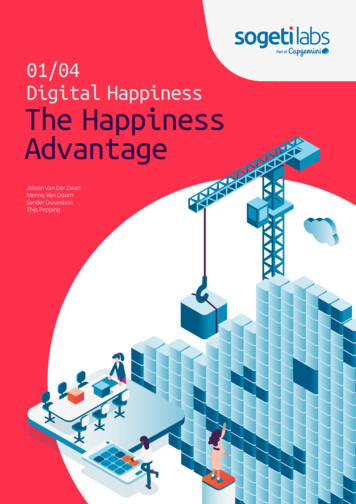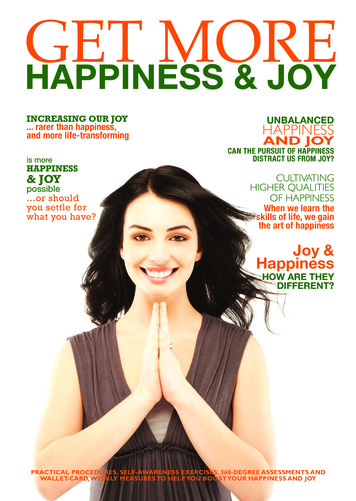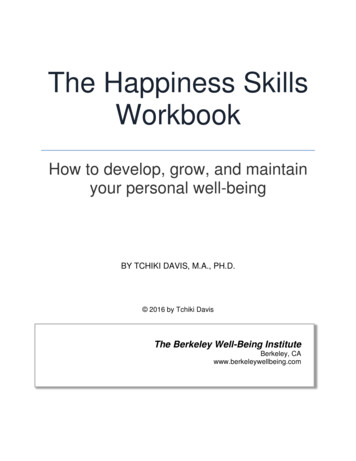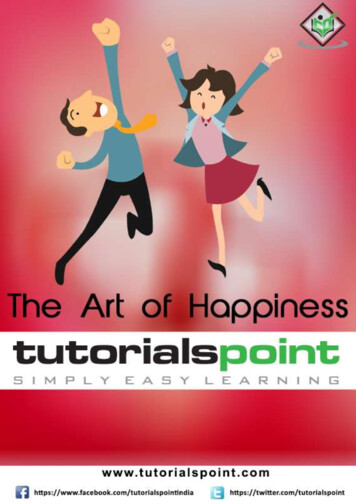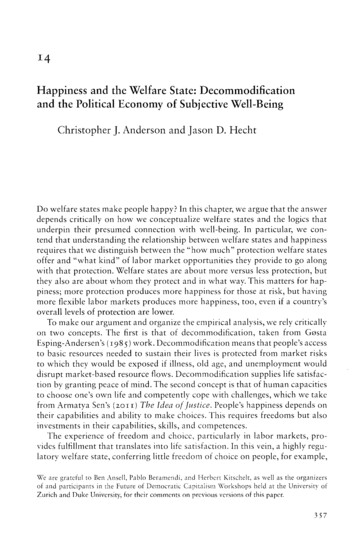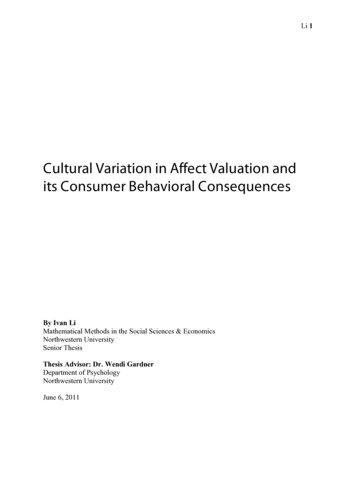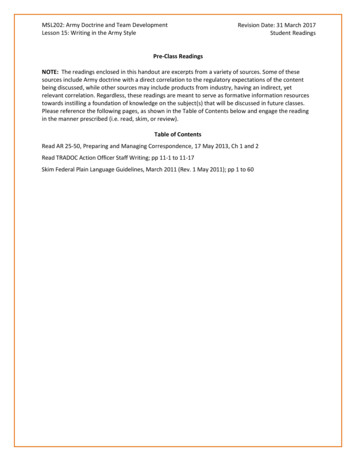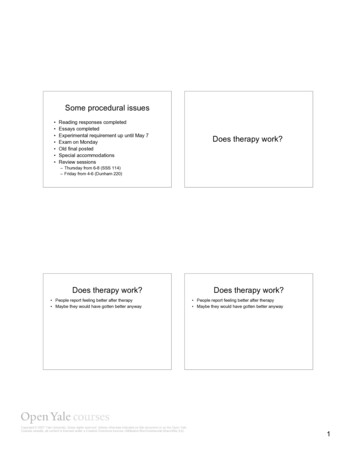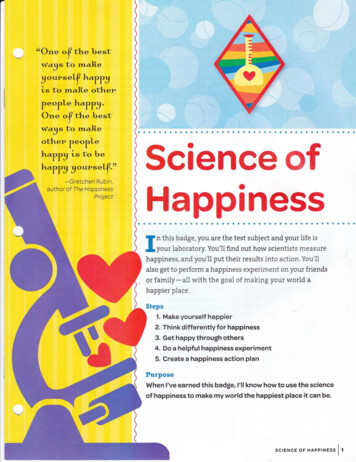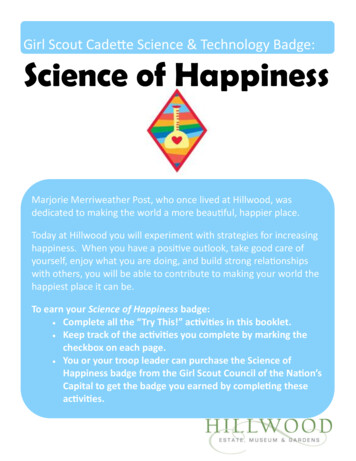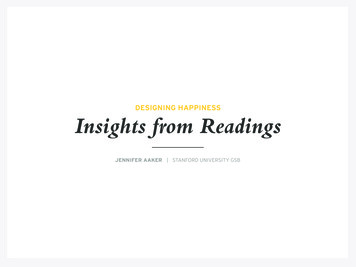
Transcription
DESIGNING HAPPINESSInsights from ReadingsJENNIFER AAKER STANFORD UNIVERSITY GSB
DESIGNING HAPPINESSInsights from ReadingsDay 1: Rethinking HappinessBUT WILL IT MAKE YOU HAPPY? - NYTIMES, AUGUST 9 2010WOULD YOU BE HAPPIER IF YOU WERE RICHER – SCIENCE 2006 (KAHNEMAN ET AL.)THE SMILING PROFESSOR : DAN GILBERT - NYTIMES, APRIL 22 2008QUANTIFIED SELF MOVEMENT (THE DATA DRIVEN LIFE) - NYTIMES, APRIL 26 2010THE PSYCHOLOGY OF HAPPINESS - AAKER GSB CASE M-330ABONUS: THE NEW SCIENCE OF HAPPINESS - TIME MAGAZINE, JANUARY 9 2005JENNIFER AAKER STANFORD UNIVERSITY GSB
BUT WILL IT MAKE YOU HAPPY?NYTIMES, AUGUST 9 2010“A 20,000 INCREASE INSPENDING ON LEISUREWAS ROUGHLY EQUIVALENTTO THE HAPPINESS BOOSTONE GETS FROMMARRIAGE.”New studies of consumption and happinessshow that people are happier when:New strategies by retailers/marketers in response:SPEND MONEY ON EXPERIENCES INSTEAD OF MATERIAL OBJECTSMERCHANDISE THAT MAKES BEING AT HOMEMORE ENTERTAININGspending money for an experience produces longer-lasting satisfactionthan spending money on stuffconsumers opting to use their extra cash for nights at home with familyor for “staycations” in the backyardMAKING CONSUMERS FEEL SPECIAL BYGIVING THEM ACCESS TO EXCLUSIVE EVENTSAND MORE PERSONAL CUSTOMER SERVICERELISH WHAT THEY PLAN TO BUY LONG BEFORE THEY BUY ITSTOP TRYING TO OUTDO EACH OTHERDESIGNING HAPPINESSInsights from Readings Day 1: Rethinking HappinessJENNIFER AAKER STANFORD UNIVERSITY GSB
WOULD YOU BE HAPPIER IF YOU WERE RICHER?SCIENCE 2006 (KAHNEMAN ET AL.)VSHappiness has not changedover the past 4 decades eventhough real income per capitahas increased significantly.Proof that we areoverstating the effect ofincome on subjectivewell being.Why income has such aweak effect on subjectivewell-being?FOCUSING ILLUSION when considering 1specific factor's effect on well-being,people tend to exaggerate its importance;may cause errors in decision makingINCREASES IN INCOME HAVE ATRANSITORY EFFECT ON REPORTEDHAPPINESSRELATIVE INCOME VERSUS ACTUALLEVEL AFFECTS HAPPINESSSTRACK AND COLLEAGUES: peopledon't actually know how happy they arebecause the answers can easily bemanipulated by things like order ofquestionsDESIGNING HAPPINESSLarge increases in income in a specificcountry over time is not correlated withwell being. Above GDP per capita of 10,000, life satisfaction does not rise ifGDP per capita risesWhen well-being is measured moment tomoment the correlation between incomeand happiness diminishesInsights from Readings Day 1: Rethinking HappinessWe adapt to material goods and thus thereis no lasting effect to an increase in incomeHappiness is connected to how peoplespend their time — on average, high incomeindividuals spend time on things that onaverage do not make them happier andactually have a higher stress levelJENNIFER AAKER STANFORD UNIVERSITY GSB
THE SMILING PROFESSORDAN GILBERT - NYTIMES, APRIL 22 2008People have an inability to predict what willmake them happy or unhappyPeople have remarkable talent for finding waysto soften the impact of negative eventsBest predictor of human happiness is humanrelationships and the amount of time thatpeople spend with family and friendsQUANTIFIED SELF MOVEMENT(THE DATA DRIVEN LIFE), NYTIMES, APRIL 26 2010Self-tracking in order to understandpeople's behavior is becoming moreand more commonAllows people to connect with oneanother in new waysDESIGNING HAPPINESSInsights from Readings Day 1: Rethinking HappinessJENNIFER AAKER STANFORD UNIVERSITY GSB
THE PSYCHOLOGY OF HAPPINESSAAKER GSB CASE M-330A“I’M HAPPY”VS40%C 50%10%What is happiness?Obstacles to happinessA: state of well-being characterized byemotions raging from contentment tointense joy; B: a pleasurable orsatisfying experiencechanges and varies over time andculture – younger people associate iswith excitement whereas older peopleassociate it with feeling peacefulWhat determines anindividual's happiness level?How to reduce unhappiness?Happiness set point (S) lifecircumstances (C) intentional/voluntary activities (V)Money vs. HappinessHappiness as a policyPoor people become happier once theyescape poverty but after that the tie betweenmoney and happiness tapers offBuhtan is dedicated to increasing GDH orGross Domestic HappinessThe more we get, the more we want – neversatisfied with what we haveUK PM Gordon Brown has shown interestin using happiness studies to advancewell being in UKFreedom of choiceHow to be happier?studies have shown that democratization,economic development, and rising socialtolerance increase perception of free choiceSpend time with otherschoice can be overwhelming andcounterproductiveDESIGNING HAPPINESSNeuro-Linguistic Programming:understanding what makes us unhappy andchanging behavior patterns/use cognitivethinking styles to reduce depressionInsights from Readings Day 1: Rethinking HappinessFlow: be fully engaged/immersed/absorbed in particular activitiesWork for a larger purposeJENNIFER AAKER STANFORD UNIVERSITY GSB
THE NEW SCIENCE OF HAPPINESSBONUS!TIME MAGAZINE, JANUARY 9 2005What makes us happy?How to measure happiness?How to make yourself happy?DIENER research: Once your basic needsare met, additional income does little toraise your sense of satisfaction with lifeDIENER Satisfaction with Life ScaleSONJA LYUBOMIRSKY gratitudejournal, a diary in which subjects writedown things for which they are thankful taking the time to conscientiously counttheir blessings once a week significantlyincreased subjects' overall satisfactionYOUTH, GOOD EDUCATION,MARRIAGE, SUNNY DAYS – NO REALCONNECTION TO HAPPINESSRELIGION, FRIENDS AND FAMILY –STRONG CORRELATION TOHAPPINESSDESIGNING HAPPINESSCSIKSZENTMIHALYI method of usingbeepers and, later, handheld computers tocontact subjects at random intervalsKAHNEMAN method: the dayreconstruction method. Result: threecomponents of happiness: pleasure,engagement, and meaningInsights from Readings Day 1: Rethinking Happinessperforming acts of altruism or kindnessevery person feels happier when they'rewith other peopleJENNIFER AAKER STANFORD UNIVERSITY GSB
DESIGNING HAPPINESSInsights from ReadingsDay 2: Measuring HappinessHappiness is heterogenous, heavily influenced by demographics, pscyhographics andculture. Measuring Happiness investigates three elements: understanding; surveying;and hypothesizing about happiness around the world, leveraging the We Feel Finedata engine to explore happiness and associated emotions.ECONOMICS DISCOVERS ITS FEELINGSSTUMBLING ON HAPPINESSTHE PURSUIT OF HAPPINESS: TIME, MONEY, AND SOCIAL CONNECTIONWEALTH AND HAPPINESS ACROSS THE WORLDACCOUNTING FOR THE RICHNESS OF DAILY ACTIVITIESJENNIFER AAKER STANFORD UNIVERSITY GSBSummary by Helen Belogolova, Jason Chua, Purin Phanichphant, and Michael Turri
ECONOMICS DISCOVERS ITS FEELINGSTHE ECONOMIST, DECEMBER 19 200619th Century Economists Calculated happiness as good feelingsminus bad Believed pursuit of pleasure/avoidance ofpain drove human beings Gave up to study outward behavior becauseno good way of measuring feelingsDESIGNING HAPPINESSExperiences TrumpCommoditiesexperiences often involvecommodities, making themdifficult to separate.TodayHappiness Unchangedfor 50 YearsMeasurements taken by askingquestions and utilizing newtechnologies such as MRIThe rich are happier than the poor,but rich countries do not get happieras they get richer.Kahneman'sColonoscopy ExperimentDoing Better Than YouExperience defined by the worst and lastmoments rather than the length.Doing well is not enough, we need todo better than others: fastest car,biggest houseFallible MemoriesFinding FlowMemories of certain experiences actuallyseem better than the experience itself,leading people to repeat unpleasantexperiences.Historically, we work to live, butCsikszentmihalyi experiment fromweek 1 found that people derivepleasure from finding flow in workInsights from Readings Day 2: Measuring HappinessJENNIFER AAKER STANFORD UNIVERSITY GSB
STUMBLING ON HAPPINESSDANIEL GILBERT, CH.2: A VIEW FROM IN HERE & CH.3: OUTSIDE LOOKING INBig Idea:3 types of “Happiness”Which feels/is better?HOW DO WE KNOWWHAT HAPPINESS ISAND HOW MIGHT WEMEASURE IT?EMOTIONAL HAPPINESSA subjective state or "you-know-what-I-mean" feeling.Hard to describe because it can only be defined indirectlyby the actions that cause it or experiences to which it issimilar.We have no way of knowing. Thereis no way for the same person tomake a simultaneous side-by-sidecomparison of the different "types"of happiness. Asynchronouscomparisons are unreliable due toour faulty memories.MORAL HAPPINESSGood feelings that result from virtuous actions ratherthan shallow pleasures. Advocated by most theologiansand philosophers as something we should strive to attain.JUDGEMENTAL HAPPINESSBeing happy "about" something. Recognizing thatsomething could or should cause pleasure for someonewhile not actually experiencing it firsthand.DESIGNING HAPPINESSInsights from Readings Day 2: Measuring HappinessJENNIFER AAKER STANFORD UNIVERSITY GSB
STUMBLING ON HAPPINESSDANIEL GILBERT, CH.2: A VIEW FROM IN HERE & CH.3: OUTSIDE LOOKING IN“THESE GO TO ELEVEN.”http://www.youtube.com/watch?v EbVKWCpNFhYPeople seem to have different ideas ofwhat happiness really is. How do weaccount for that?Given that happiness is sosubjective, how can we reliablymeasure it?MAIN POINTHappiness is always experienced from someone's point of view; it isan experience that is colored by our previous experiences andcannot be wholly recreated after it occurs.ALWAYS FUZZYMeasurements of happiness will always be a bit fuzzy due to thesubjective nature of the experience.LANGUAGE-SQUISHING HYPOTHESISEveryone has the same subjective experience of an identical event,but their happiness scales are calibrated differentlyFIRSTHAND, REAL-TIME IS LEAST FLAWEDA firsthand, real-time report of an individual's experience is the leastflawed measure of happiness because the individual is the onlyobserver stationed at the critical point of view.EXPERIENCE-STRETCHING HYPOTHESISHappiness scales stretch when we have new experiences, so whatused to be an 8 on one's scale might become a 5 after aparticularly pleasurable experienceHUGE SAMPLE SIZEImperfections in measurement can be overcome if recognized andcombated with huge sample sizes that even out variability inresponses. (we feel fine data)DESIGNING HAPPINESSInsights from Readings Day 2: Measuring HappinessJENNIFER AAKER STANFORD UNIVERSITY GSB
THE PURSUIT OF HAPPINESS:TIME, MONEY, AND SOCIAL CONNECTIONPSYCHOLOGICAL SCIENCE, 2010, CASSIE MOGILNERBig IdeaResults: YESImplicationsDoes thinking about time ratherthan money influence howindividuals pursue happiness?Specifically, does it affect theamount of time people spend onwork (not so great for long termhappiness) vs. socialization (goodfor long term happiness)?People who were thinking about time exhibitedsignificantly higher social behavior than those incontrol conditions. This was true for all socioeconomicgroups and in both laboratory and field conditions.Creating environments where theidea of time is salient can influenceindividuals' behavior in ways thatpromote social behavior andtherefore long term happiness.DESIGNING HAPPINESSMoney in general tended to increase individualisticbehavior among participants (neutral effect on those inlower socioeconomic brackets).Insights from Readings Day 2: Measuring HappinessJENNIFER AAKER STANFORD UNIVERSITY GSB
WEALTH AND HAPPINESS ACROSS THE WORLDJOURNAL OF PERSONALITY AND SOCIAL PSYCHOLOGY, 2010, VOL. 99, NO. 1, 52–61 (DIENER ET AL)Questions ExaminedPredictionsStudy Structure1. How does income relate to different typesof well-being?1. Life satisfaction correlateswith income2. What mediates the relationship betweenwell-being and income?2. Positive feelings correlatewith social-psychologicalrewardsGALLUP ORGANIZATION136,839 people132 countries from 2005-2006(Example: association of well-being mediatedby the fact that wealthy people are morelikely to have their needs met or because theyhave their material needs met?3. Is the relationship between well-being andincome consistent across various groups?(Example: Is income more important to wellbeing in poorer nations?)3. Negative feelings correlateswith fulfillment of basic needs4. What types of well-being aremore affected by fulfilling goalsversus meeting needs?4. Are citizens of wealthy nations happierthan those of poor countries?SWB MEASURESGlobal Life Evaluation Measure: Evaluated currentlife on a scale from 0 to 10 – reflective judgment onpeople’s lives compared with what they want themto be. Positive and Negative feelings experiencedyesterday (reduces memory bias)ECONOMIC PREDICTORS Household Income Modern luxury conveniences such as television Per capita GDP to asses national wealthSOCIAL PSYCHOLOGICAL PREDICTORS Respect Closeness/trust with others Hours worked previous dayDESIGNING HAPPINESSInsights from Readings Day 2: Measuring HappinessJENNIFER AAKER STANFORD UNIVERSITY GSB
WEALTH AND HAPPINESS ACROSS THE WORLDJOURNAL OF PERSONALITY AND SOCIAL PSYCHOLOGY, 2010, VOL. 99, NO. 1, 52–61 (DIENER ET AL)Study ResultsAVERAGE HAPPYAverage person in the world was relativelyhappy, a bit above neutral when comparingpositive versus negative feelingsMAJORITY PSYCHOLOGICAL NEEDS METBasic needs were unmet in 25% ofrespondents, while most people had theirpsychological needs metSTRONGEST CORRELATES Income and national income Satisfaction with standard of living andownership of luxury conveniences For feelings, strongest predictor wasfulfillment of psychological needsI USPeople’s satisfaction with life is stronglyinfluenced by the general circumstances oftheir respective societiesANGLO VS. LATINNorth European and Anglo societies are mostsuccessful in economic area, while Latinsocieties are relatively high in socialpsychological well-beingDESIGNING HAPPINESSRUSSIA SOUTH KOREARussia and South Korea are substantiallylower in social psychological prosperity/positive feelings than in incomeINCOME VS. WELL-BEINGRelation of income and well-being was high forlife evaluations but weaker for feelings whichwere more strongly associated with socialpsychological prosperity as predictedUNEXPECTED FINDINGRelationship between income and lifeevaluations was slightly stronger in wealthynations than in poor ones counters the ideathat money is most important when it helpsmeet basic needsInsights from Readings Day 2: Measuring HappinessFuture QuestionsSHORT TERM vs. LONG TERMAssess feelings over longer periods oftime in order to distinguish betweenshort-term and long-term processesINCOME SCALEUse different scaling of income thanlog income?JENNIFER AAKER STANFORD UNIVERSITY GSB
ACCOUNTING FOR THE RICHNESS OF DAILY ACTIVITIESPSYCHOLOGICAL SCIENCE 2010 (WHITE, DOLAN)Big IdeasResults (n 1825)TakeawaysAre pleasure and reward linked in dailyactivities?PRAYER/EXERCISE/SOCIALIZINGMore pleasurable/rewarding than averageDoes duration play a role in perceivedpleasure and reward.COMMUTING/SELF-CARELess pleasurable/rewarding than averageWORKINGAlthough not necessarily pleasurable, work isfairly rewarding, which could explain whysome people work so many hours versusmaximizing pleasure (maximizing SWB)How can we mix and match daily activitiesto maximize subjective well-being.WORK/HOUSEWORKLess pleasurable, but highly rewarding;only work was significantly more rewardingthan spending time with childrenThree Approaches toAssessing People’s LivesOBJECTIVE INDICATORSe.g. health and education levelINCOME INDEXDegree to which people can satisfy theirdesires indexed by incomeSUBJECTIVE WELL-BEING (SWB)How people think and feel about their livesTV/EATINGMore pleasurable, but less rewardingDURATIONLonger more pleasurable and rewardingShorter less pleasurable and rewardingWeighted for duration, work was no longerless pleasurable than time with childrenand socializing/exercise etc. became muchmore rewarding than time with children.Day Reconstruction Method(Kahneman, Krueger, Schkade, Schwarz, and Stone, 2004) Recall and divide previous day intoepisodes and record: Duration, Activities,People present, Feelings at the time major weakness: focus on feelingsDESIGNING HAPPINESSInsights from Readings Day 2: Measuring HappinessDISCRETIONARY TIMEMix and match: pleasure from TV and rewardfrom volunteering (maximizing SWB)TIME SPENT WITH CHILDRENMore rewarding than pleasurableQuestionsACCURACYTo what extent are reports “true” reflections ofexperiences? Are people making unpleasantexp. rewarding in their mind to justify them?TIMEWhat is the SWB associated with a unit of timein each activity? If marginal rates of pleasure/reward diminish over time, longer episodes lower satisfaction overallPOLICYMAKERS/SOCIETYWhat are the big challenges when pleasure andreward tell different storiesJENNIFER AAKER STANFORD UNIVERSITY GSB
DESIGNING HAPPINESSInsights from ReadingsDay 3:Visualizing HappinessDesigning happiness is about designing experiences. We take a closer look at theanticipating-experience-remembering framework for developing happy experiencesand move on to understanding how doing good means doing well.VISUALIZING DESIREHOW THE EXPERIENCE OF HAPPINESS SHIFTS ACROSS THE LIFE COURSERECALLING MIXED EMOTIONSTHE SUMMONED SELFNIKE WE: DESIGN MEETS SOCIAL GOODJENNIFER AAKER STANFORD UNIVERSITY GSBSummary by Helen Belogolova, Jason Chua, and Purin Phanichphant
VISUALIZING DESIREBRIAN KNUTSON, STANFORD YOUTUBE VIDEO?WHAT HAPPENS IN THE BRAIN WHENPEOPLE EVALUATE THINGS LIKE BEER,CARS AND POLITICIANS.Real-time brain activityAnticipating pleasureRisk-takingBy using money as a motivatingstimulus, and fMRI as a way to recordreal-time brain activity, Knutson studylinked activation of a subcorticalregion of the brain to the anticipationof pleasure or reward.When a person thinks about making adecision that could result in a monetaryreward, neurons fire in the brain'ssubcortex and in the prefrontal cortex. Thesubcortex appears to ponder the size ofthe prize, while the prefrontal cortexexamines the odds of getting it.In subsequent experiments, Knutsonand team was able to predict risktaking behavior (purchasingsomething, buying stocks) by lookingat the level of activation in this region.DESIGNING HAPPINESSInsights from Readings Day 3:Visualizing HappinessJENNIFER AAKER STANFORD UNIVERSITY GSB
HOW THE EXPERIENCE OF HAPPINESSSHIFTS ACROSS THE LIFE COURSEMOGILNER, KAMVAR, AAKERMain IdeaAlthough the level of reported happinessis fairly constant across all age ranges,what is construed as happiness changesover time. Younger people tend toassociate excitement and happiness withone another, while older people grouppeacefulness and happiness.Different responses todifferent stimuliOne study randomly assigned participantsto listen to either an exciting or peacefulversion of a song. Among the exciting songgroup, younger participants reportedgreater levels of happiness, and among thepeaceful song group, older participantsreported greater levels of happiness.Why is this?As we get older and our futurehorizons contract, we turn ourattention increasingly toward thepresent. The increased salience oftime leads us to associate happinessmore closely with peacefulness (seeMogilner reading from Day 2).DESIGNING HAPPINESSIs this manipulable?Yes. When younger participants were walkedthrough meditation exercises designed tohelp them focus on the present, they beganto associate peaceful feelings more closelywith happiness bringing their views more inline with the older demographic (Study 4).Insights from Readings Day 3:Visualizing HappinessHow might we use thisinformation to promotehappiness?Promote different kinds of activities/products among different age groupsto cater to their preference forexciting or peaceful experiences(extrapolated from Study 5).Manipulate the salience of time tobring everyone's experience ofhappiness in line with each other(extrapolated from Study 4).JENNIFER AAKER STANFORD UNIVERSITY GSB
RECALLING MIXED EMOTIONS2009 AAKER ET ALHow does complexity affectmemories of emotions?Cultural differences inmixed emotions responsesSummary resultsof both studiesMany times, we experience emotions that arenot purely happy or sad, but rather a mixtureof the two. Common examples includetransitions (breakups, relocation) and testtaking (score anxiety, peer comparison). Ourmemory of emotions is imperfect and shiftsover time (see Gilbert reading from Day 2) howdoes emotional complexity affect our recall?Participants from Anglo-Americanbackgrounds reported higher levels ofconflict with mixed emotions than thosefrom Asian or Asian-American backgrounds.This level of reported conflict was highlycorrelated to how well these emotions wererecalled later. Interestingly, however, bothgroups were able to describe the"mixedness" of the original stimulus.Mixed emotion experiences are moredifficult to recall correctly compared tounipolar ones; over time, peopleremember mixed emotions as less mixed;memory bias is particularly pronouncedfor Anglo-Americans who tend to feelmore conflicted when experiencing mixedemotions and thus are more motivated toresolve the conflict.Mixed emotions cause conflictand are recalled less accuratelythan unipolar emotions.MBA students were asked to describe theiremotional state immediately after receiving testscores, and then to recall these emotions 2weeks later. If they initially had reported havingmixed emotions, the students had difficultyremembering how intense these emotions were.However, if the students initially reported moreunipolar emotions, they recalled their emotionsas being more intense then their originalreports. Recall of emotional intensity had astrong negative correlation with the level ofconflict the students felt.DESIGNING HAPPINESSInsights from Readings Day 3:Visualizing HappinessJENNIFER AAKER STANFORD UNIVERSITY GSB
THE SUMMONED SELFDAVID BROOKS, NYTIMES OP-ED, AUGUST 2 2010TWO WAYS TOTHINK ABOUT LIFEWell-Planned LifeLife is a well designed project. Once youdefine a clear purpose for your life, you canallocate your time, energy and talentaccordingly, and eventually fulfill your longterm goals. This means investing time inimportant relationships (spousal, children)even if there are no short-term payoffs. Thisview is very American in its focus on personalagency and asks "what should I do?"Summoned LifeLife isn’t a project, but an unknowablelandscape that needs to be explored. Youcannot know what needs to be done orwhere you fit into the larger picture until youare engaged in it. This human landscape isanchored by commitments to others (people,causes, nations) that defy traditional viewsof costs and benefits, investments andreturns. The Summoned Life reachesfulfillment when the individual dissolves intoa larger collective project or cause.DESIGNING HAPPINESSInsights from Readings Day 3:Visualizing HappinessJENNIFER AAKER STANFORD UNIVERSITY GSB
NIKE WE: DESIGN MEETS SOCIAL GOODAAKER GSB CASE M-328A Giving CommunityCall to ActionSharing ExperiencesNike employees were passionate about givingback to their surrounding communities, butNike had no well-defined mechanisms by whichthey could enable this giving. The WE portalwas developed with feedback from employeesand acts as a philanthropic umbrella for allNike employees.Nike categorized the philanthropic effortson their portal into four giving mechanismsthat emphasized a call to action – “GiveMoney”, “Give Time”, “Give Talent” and“Give Voice”Employees are able to share theirphilanthropic experiences through a bloglocated on the portal. These blog postsserve as inspiration for more social good,and keeps the community updated on theimpact each team is making.Getting PersonalCompeting for CharityThe WE portal allows employees to indicatewhat sorts of philanthropic activities they mostconnect with, then filters opportunitiesaccordingly. Additionally, employees areempowered to post opportunities that matter tothem and invite others to join them.Although Nike initially intended to keep theamount of Giving Points earned byemployees for participating inphilanthropic activities private, thecompany discovered that the competitionfostered by making Points data publichelped motivate the community to domore good. The accompanying WEMarketplace allows employees to tradeGiving Points for Nike product to bedonated to schools, nonprofits and NGOs.DESIGNING HAPPINESSInsights from Readings Day 3:Visualizing HappinessJENNIFER AAKER STANFORD UNIVERSITY GSB
DESIGNING HAPPINESSInsights from ReadingsDay 4: Delivering HappinessWe’ll make the business case for happiness, diving into how companies architect,deliver and amplify happiness. We’ll spot light the Coke case where productgroups will be formed to design a branded campaign that would cultivate andspread happiness for consumers.DAN PINK: DRIVE AND MOTIVATIONHAPPINESS IS CONTAGIOUSHELP EMPLOYEES GIVE AWAY SOME OF THAT BONUSTHE DRAGONFLY EFFECT — CHAPTER 1COKE: DISPENSING HAPPINESSJENNIFER AAKER STANFORD UNIVERSITY GSBSummary by Helen Belogolova, Jason Chua, and Purin Phanichphant
DAN PINK: DRIVE AND MOTIVATIONYOUTUBE VIDEO BY RSA ANIMATE (20 MOINUTES)More money doesn’t alwaysyield better results.An MIT study challenged students to perform a variety of physical andcognitive tasks, and gave them small, medium or large rewards.Researchers found that while the students' performance on purelymechanical tasks increased with the size of the reward, for tasks requiringeven a little bit of cognitive skill, there was an inverse relationship betweenreward and performance.WHAT ROLE DOES MONEY PLAY IN MOTIVATING US?Money only motivates us up to a certain point. Once we are being paidenough so that monetary compensation is not at the forefront of ourminds, increasing pay doesn't do very much in terms of motivation.What does motivate us?1. AUTONOMY – Feeling like you have control over what you're doingleads to more engagement.2. MASTERY – Getting better at something and challenging ourselvesmakes us feel good and is fun.3. PURPOSE - Using our talents to contribute to a larger cause givesus a feeling of connection to others.PURPOSE PROFITWhen the purpose motive is in line with the profit motive, great thingscan happen. Skype and Apple are example of how a cleartransformative vision has led to incredible financial results.DESIGNING HAPPINESSInsights from Readings Day 4: Delivering HappinessJENNIFER AAKER STANFORD UNIVERSITY GSB
HAPPINESS IS CONTAGIOUSTHE LIKELIHOOD THATYOU ARE HAPPY:CNN, JANUARY 9, 2009HAPPINESS SPREADS THROUGH SOCIALNETWORKS. THE HAPPINESS OF APERSON UP TO THREE DEGREESREMOVED FROM YOU HAS AN EFFECTON YOUR LEVEL OF HAPPINESS. 15%10%6%if a friend is happyif a friend of a friend is happyif a friend of a friend of a friend is happyHow about onlinesocial networks?Happiness comes inlarge numbers?What else iscontagious?There seems to be a similar effectpresent in virtual networks such asFacebook. Researchers have found thatpeople with smiling profile pictures tendto have friends that are also smiling intheir profile pictures.The study found that people with largewebs of social connections were morelikely to become happy. However, it alsofound that happiness was not directlycorrelated to the size of one's friendgroup; people with a smaller number ofvery close friends still reported highlevels of happiness.Researchers found that the level ofobesity and smoking behavior in one'ssocial network was correlated with anindividual's likelihood of being obeseor a smoker. Sadness was also foundto spread throughout social networks,although to a lesser extent thanhappiness.DESIGNING HAPPINESSInsights from Readings Day 4: Delivering HappinessJENNIFER AAKER STANFORD UNIVERSITY GSB
HELP EMPLOYEES GIVE AWAY SOME OF THAT BONUSHBR 2008 (NORTON AND DUNN)Big IdeaEmployees get a boost in happiness not from spending moneyon themselves, but rather by engaging in prosocial actionsand spending money on others.Size Doesn’t MatterResearchers gave two groups of people either 25 or 5, andtold them to spend it on themselves or on others. They foundthat regardless of whether they gave 25 or 5, the group thatspent their money on others reported significantly higherlevels of happiness.Creating Opportunities for HappinessManagers might consider providing employees withopportunities to help others in addition to themselves. In 2007,Google gave employees a 100 certificate forDonorsChoose.org where they could select a charity tocontribute money to. Allowing employees to take an active rolein corporate charitable contributions has the potential toincrease levels of happiness.DESIGNING HAPPINESSInsights from Readings Day 4: Delivering HappinessJENNIFER AAKER STANFORD UNIVERSITY GSB
THE DRAGONFLY EFFECT — CHAPTER 1JENNIFER AAKER & ANDY SMITHfocustake actiongrabattentionengageWhat is thedragonfly effect?What sorts of ideasgenerate ripple effects?The Dragonfly Model:Focus GETIt's the idea that passionate peoplecan make a positive impact in theworld on a scale that isdisproportionate to their resourcesby harnessing the power of networks,participation, and ripple effects.Ideas that are centered around creatingdeeper meaning tend to be the ones thataffect people that come into contact withthem. Research has shown that positiveemotions such as happiness, andmovements promoting social good aremore readily spread than negative or lesshuman-centered ideas.FOCUS: Identify a single concrete andmeasurable goal.GRAB ATTENTION: Make someone look.Cut through the noise with somethingunexpected, visceral and visual.ENGAGE: Create a personal connectionthrough empathy, authenticity and storytelling.TAKE ACTION: Empower people tobecome active participants in the cause,and continuously tweak things thataren't workingDESIGNING HAPPINESSInsights from Readings Day 4: Delivering HappinessJENNIFER AAKER STANFORD UNIVERSITY GSB
COKE: DISPENSING HAPPINESSAAK
culture. Measuring Happiness investigates three elements: understanding; surveying; and hypothesizing about happiness around the world, leveraging the We Feel Fine data engine to explore happiness and associated emotions. Summary by Helen Belogolova, Jason Chua, Purin Phanichphant, and Michael Turri
